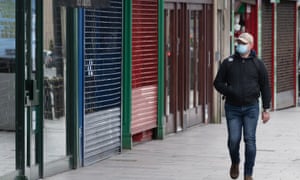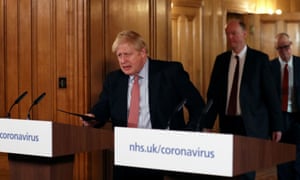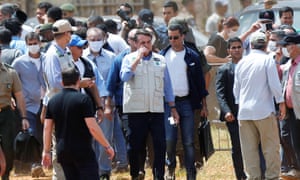Quebec and Ontario have been hit hardest, but as the virus spreads concern for Canada’s remote Indigenous communities is growing
Leyland Cecco in Toronto THE GUARDIAN Wed 15 Apr 2020
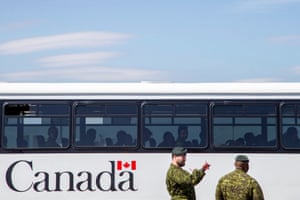
Canadian forces members in Toronto fan out across the
country to help fight the coronavirus pandemic.
Photograph: Carlos Osorio/Reuters
Every day for nearly a month, Justin Trudeau has emerged from his residence – rain, shine or snow – with a message that the only way for his country to beat back the coronavirus is with a herculean “Team Canada” effort.
His deputy, Chrystia Freeland, has likened fighting the pandemic to a national wartime effort. Even the conservative premier of Ontario, Doug Ford – once a rival to Trudeau’s Liberals – has called for unity.
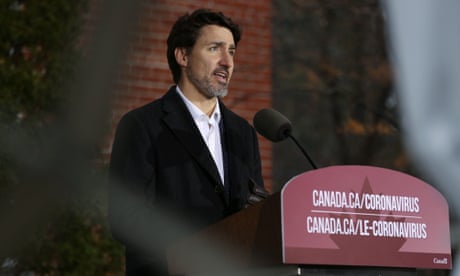
Trudeau warns Canada's coronavirus shutdown likely to remain for weeks
All of Canada’s provinces have declared states of emergency and called on residents to practice physical distancing, often using the length of a hockey stick as a model. But as the virus moves across the country, vast disparities have emerged as provinces anticipate starkly different caseloads and fatalities.
Quebec has seen 13,500 documented cases of the coronavirus. But in two of the country’s sparsely populated northern territories – the Yukon, Northwest Territories – only 13 confirmed cases have been logged. Not a single case has been reported in the sprawling territory of Nunavut.
Meanwhile, British Columbia appears to have started “flattening” the curve of its outbreak.
These vast regional differences – a function of geography, policy and luck – have only been magnified in recent weeks as Canada reported 26,897 cases and nearly 900 deaths from the coronavirus on Tuesday.
Compared with its southern neighbour, Canada’s response has been largely coordinated and swift: in the United States, critical weeks lagged between the application of lockdowns in different states, but it took only a few days before schools across Canada were shut down and residents were being asked to stay at home.
Nonetheless, tens of thousands of Quebec residents left for Europe and the United States in early March for the province’s spring break – one of the earliest in the country. That accident of timing meant that Quebec went on to become the centre of the country’s outbreak.
On the other side of the country, British Columbia’s spring break wasn’t until mid-March, leaving officials with enough to time to request residents refrain from travelling, order schools shut down and plead for residents to physically distance themselves.
That call, from the province’s top doctor, Bonnie Henry, has taken on a prescient quality: the province’s case numbers remain disproportionally low. “Some parts of it are luck, and some parts of it are being prepared,” she said recently.
In Ontario, where cases continue to increase, Ford also initially encouraged families to enjoy their vacation. “Go away, have a good time, enjoy yourself,” he said – before tempering his message a few days later.
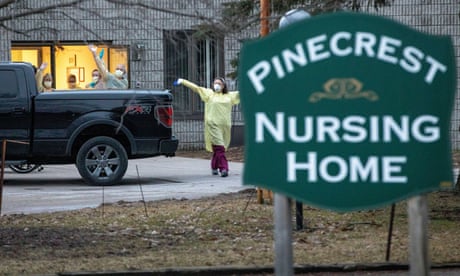
Canada nursing home reels from death of almost half its residents
With the second-highest number of cases in the country, Ontario has previously said its supply of personal protective equipment was run critically low – a challenge exacerbated after American officials temporarily halted a new shipment of respirators.
“We’ve been asked to be more parsimonious with our safety equipment, to not change our masks unless we think that we’ve been exposed or somehow compromised,” said James Maskalyk, an emergency room doctor in downtown Toronto.
“But we have enough for today. And at this point, that’s what matters. We’re mindful that everyone on the planet is in the same situation that we are.”
Resources in Ontario have not yet been fully strained – as they have in hospitals in New York or northern Italy. But Kulvinder Gill, head of Concerned Ontario Doctors, cautioned that celebration would be premature.
“On the frontlines we are essentially blind to the true reality of Covid-19 in our province,” she said. “We have the lowest per capita testing in Canada, so we are only capturing a very tiny fraction of known cases.”

Justin Trudeau has emphasized his country’s ‘Team Canada’
Every day for nearly a month, Justin Trudeau has emerged from his residence – rain, shine or snow – with a message that the only way for his country to beat back the coronavirus is with a herculean “Team Canada” effort.
His deputy, Chrystia Freeland, has likened fighting the pandemic to a national wartime effort. Even the conservative premier of Ontario, Doug Ford – once a rival to Trudeau’s Liberals – has called for unity.

Trudeau warns Canada's coronavirus shutdown likely to remain for weeks
All of Canada’s provinces have declared states of emergency and called on residents to practice physical distancing, often using the length of a hockey stick as a model. But as the virus moves across the country, vast disparities have emerged as provinces anticipate starkly different caseloads and fatalities.
Quebec has seen 13,500 documented cases of the coronavirus. But in two of the country’s sparsely populated northern territories – the Yukon, Northwest Territories – only 13 confirmed cases have been logged. Not a single case has been reported in the sprawling territory of Nunavut.
Meanwhile, British Columbia appears to have started “flattening” the curve of its outbreak.
These vast regional differences – a function of geography, policy and luck – have only been magnified in recent weeks as Canada reported 26,897 cases and nearly 900 deaths from the coronavirus on Tuesday.
Compared with its southern neighbour, Canada’s response has been largely coordinated and swift: in the United States, critical weeks lagged between the application of lockdowns in different states, but it took only a few days before schools across Canada were shut down and residents were being asked to stay at home.
Nonetheless, tens of thousands of Quebec residents left for Europe and the United States in early March for the province’s spring break – one of the earliest in the country. That accident of timing meant that Quebec went on to become the centre of the country’s outbreak.
On the other side of the country, British Columbia’s spring break wasn’t until mid-March, leaving officials with enough to time to request residents refrain from travelling, order schools shut down and plead for residents to physically distance themselves.
That call, from the province’s top doctor, Bonnie Henry, has taken on a prescient quality: the province’s case numbers remain disproportionally low. “Some parts of it are luck, and some parts of it are being prepared,” she said recently.
In Ontario, where cases continue to increase, Ford also initially encouraged families to enjoy their vacation. “Go away, have a good time, enjoy yourself,” he said – before tempering his message a few days later.

Canada nursing home reels from death of almost half its residents
With the second-highest number of cases in the country, Ontario has previously said its supply of personal protective equipment was run critically low – a challenge exacerbated after American officials temporarily halted a new shipment of respirators.
“We’ve been asked to be more parsimonious with our safety equipment, to not change our masks unless we think that we’ve been exposed or somehow compromised,” said James Maskalyk, an emergency room doctor in downtown Toronto.
“But we have enough for today. And at this point, that’s what matters. We’re mindful that everyone on the planet is in the same situation that we are.”
Resources in Ontario have not yet been fully strained – as they have in hospitals in New York or northern Italy. But Kulvinder Gill, head of Concerned Ontario Doctors, cautioned that celebration would be premature.
“On the frontlines we are essentially blind to the true reality of Covid-19 in our province,” she said. “We have the lowest per capita testing in Canada, so we are only capturing a very tiny fraction of known cases.”

Justin Trudeau has emphasized his country’s ‘Team Canada’
approach to fighting the virus.
Photograph: Dave Chan/AFP via Getty Images
With current measures remaining in place, Ontario has suggested as many as 15,000 people could die over the course of the pandemic, which officials say could last as long as two years. But experts say the province’s testing is inadequate and fails to capture the spread of the virus.
“Modelling is only as good as the data that you have. And we have such terrible data that it’s impossible to come up with any sort of accurate modelling from it,” said Gill.
In the western Prairie provinces, doctors have watched with a cautious optimism after surveying the battles outside their borders.
“A lot of us feel like it’s the calm before the storm,” said Brittany Ellis, an emergency room physician involved in pandemic response planning in the city of Saskatoon. “But Saskatchewan is more sparsely populated than other regions – and we also have the benefit of time. Many contagious diseases tend to start in places that have extensive international travel. We really don’t have a lot of that.
RIGHT TO LIFE GOVT DOES NOT CARE ABOUT LIFE, JUST OIL
In neighbouring Alberta, which has long tied its fortunes to the price of oil, the provincial government has been forced to manage both an unfolding pandemic and an energy crisis. Last week, the price of Canadian oil dipped below $4 a barrel.
“The shutdown in much of our economy is having a devastating impact,” said the premier, Jason Kenney, who suggested as much as a quarter of the province’s workforce could be out of a job. An unemployment rate of 25% would be worse than anything experienced in the rest of the country. At the same time, the province has forecast as many as 3,100 deaths and hundreds of thousands of Covid-19 infections.
Experts fear that the worst of the pandemic is likely to be felt in remote Indigenous communities, where many residents already suffer from underlying health issues.
“You’ve got populations that are malnourished, living in overcrowded conditions with higher levels of co-morbidities – chronic obstructive lung disease, cardiovascular disease and obesity – that are now going to get a virus,” said Anna Banerji, director of global and indigenous health at the University of Toronto’s faculty of medicine. “Especially with the overcrowding, I’m sure this virus will spread quickly.”
She and colleagues have started a petition demanding the federal government allocate more resources to Indigenous communities, many of which are only accessible by air.
On Tuesday, the federal government announced plans to increase funding for communities in the north. An aid package of C$130m ($94m) allocates funds to help the territories prepare their health and social services and subsidize the cost of food and hygiene products. The new funding is separate from the C$305m previously announced with the aim of helping Indigenous communities prepare for the virus.
But territorial leaders worry the funding, which they have requested for weeks, has come too late.
“Nunavut is chronically underfunded, and we cannot be expected to deal with this new global reality from behind the starting line,” said Nunavut premier Joe Savikataaq.
And while regions like Nunavut have so far been spared an outbreak, Banerji believes it is only a matter of time before the virus arrives.
“If a whole bunch of people become sick in the Canadian Arctic or in these remote communities, and these people are getting sick from the coronavirus, then what happens?” she said. “People will die.”
With current measures remaining in place, Ontario has suggested as many as 15,000 people could die over the course of the pandemic, which officials say could last as long as two years. But experts say the province’s testing is inadequate and fails to capture the spread of the virus.
“Modelling is only as good as the data that you have. And we have such terrible data that it’s impossible to come up with any sort of accurate modelling from it,” said Gill.
In the western Prairie provinces, doctors have watched with a cautious optimism after surveying the battles outside their borders.
“A lot of us feel like it’s the calm before the storm,” said Brittany Ellis, an emergency room physician involved in pandemic response planning in the city of Saskatoon. “But Saskatchewan is more sparsely populated than other regions – and we also have the benefit of time. Many contagious diseases tend to start in places that have extensive international travel. We really don’t have a lot of that.
RIGHT TO LIFE GOVT DOES NOT CARE ABOUT LIFE, JUST OIL
In neighbouring Alberta, which has long tied its fortunes to the price of oil, the provincial government has been forced to manage both an unfolding pandemic and an energy crisis. Last week, the price of Canadian oil dipped below $4 a barrel.
“The shutdown in much of our economy is having a devastating impact,” said the premier, Jason Kenney, who suggested as much as a quarter of the province’s workforce could be out of a job. An unemployment rate of 25% would be worse than anything experienced in the rest of the country. At the same time, the province has forecast as many as 3,100 deaths and hundreds of thousands of Covid-19 infections.
Experts fear that the worst of the pandemic is likely to be felt in remote Indigenous communities, where many residents already suffer from underlying health issues.
“You’ve got populations that are malnourished, living in overcrowded conditions with higher levels of co-morbidities – chronic obstructive lung disease, cardiovascular disease and obesity – that are now going to get a virus,” said Anna Banerji, director of global and indigenous health at the University of Toronto’s faculty of medicine. “Especially with the overcrowding, I’m sure this virus will spread quickly.”
She and colleagues have started a petition demanding the federal government allocate more resources to Indigenous communities, many of which are only accessible by air.
On Tuesday, the federal government announced plans to increase funding for communities in the north. An aid package of C$130m ($94m) allocates funds to help the territories prepare their health and social services and subsidize the cost of food and hygiene products. The new funding is separate from the C$305m previously announced with the aim of helping Indigenous communities prepare for the virus.
But territorial leaders worry the funding, which they have requested for weeks, has come too late.
“Nunavut is chronically underfunded, and we cannot be expected to deal with this new global reality from behind the starting line,” said Nunavut premier Joe Savikataaq.
And while regions like Nunavut have so far been spared an outbreak, Banerji believes it is only a matter of time before the virus arrives.
“If a whole bunch of people become sick in the Canadian Arctic or in these remote communities, and these people are getting sick from the coronavirus, then what happens?” she said. “People will die.”
